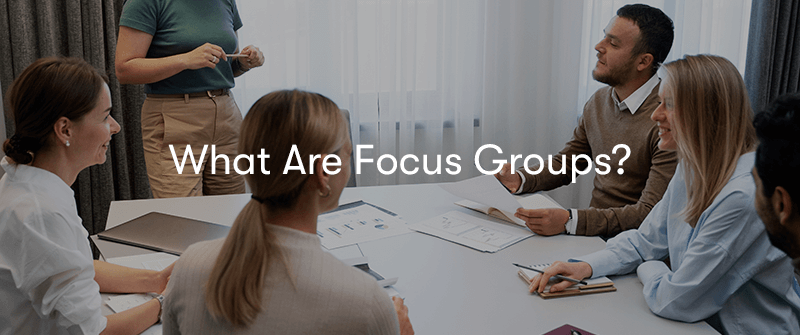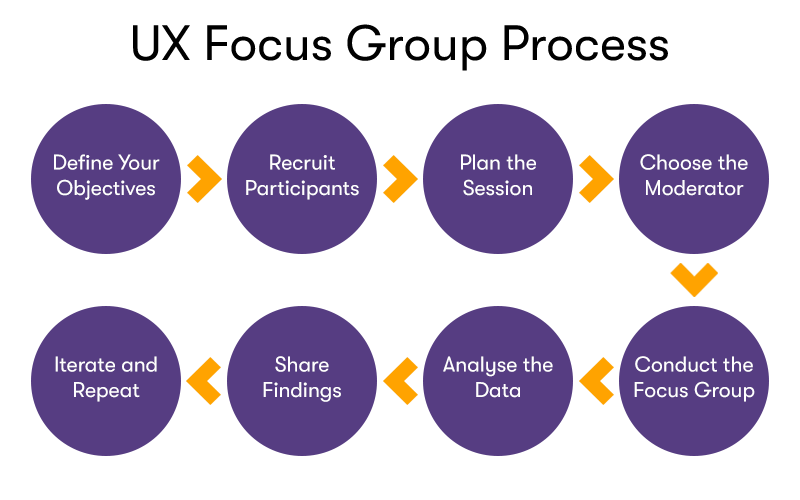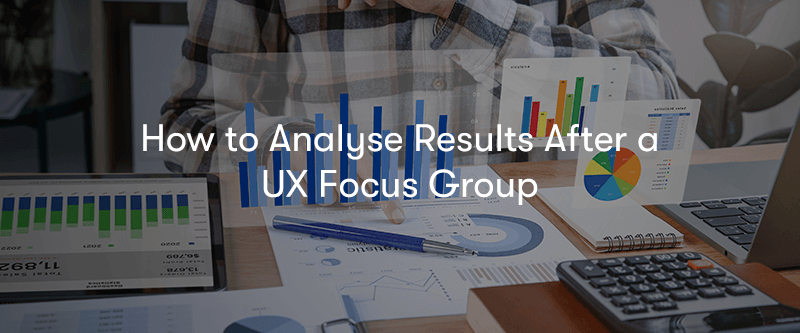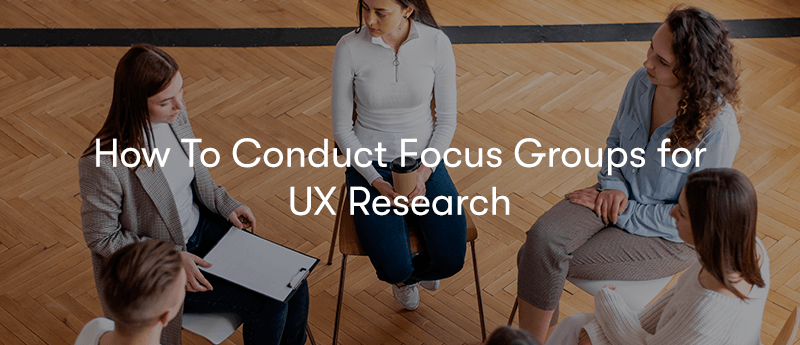How To Conduct Focus Groups for UX Research
In the realm of User Experience (UX) research, the art of understanding and enhancing the user journey is paramount. One powerful tool in achieving this goal is the Focus Group. These carefully orchestrated sessions bring together representative users to discuss their experiences, preferences, and perceptions. This exploration reveals invaluable insights, unveiling the users' unspoken needs and desires.
In this article, we delve into the intricacies of conducting Focus Groups for UX Research, shedding light on the benefits of this method and the systematic approach needed to harness its potential. Join us as we journey to enhance user experiences and shape user-centric designs.
What Are Focus Groups?

Focus groups are a qualitative research method used in user experience design to gather insights and feedback from potential or current product, service, or website users. The primary purpose of a UX focus group is to better understand user needs, preferences, and opinions regarding a specific product or design.
UX focus groups are a valuable tool in the UX research toolkit, providing a qualitative understanding of user perspectives that complements quantitative methods like surveys and analytics. Focus groups can help designers and developers create more user-centred and intuitive products and interfaces when used effectively.
How Are Focus Groups Used for UX?

Focus groups are used in User Experience to gather qualitative insights and feedback from potential users or existing product, service, or website users. They play a crucial role in understanding user needs, preferences, behaviours, and attitudes, informing the design and improvement of user interfaces and experiences. Here's how focus groups are typically used for UX:
Identifying User Needs
Focus groups can be used in the early stages of product development to identify and prioritise user needs and requirements. By discussing their experiences and pain points, participants can provide valuable input on what features or functionalities are most important to them.
Concept Testing
UX designers often use focus groups to present participants with different design concepts or prototypes. This allows designers to gauge initial reactions, preferences, and usability issues before investing in full development.
Usability Testing
Focus groups can be employed to conduct usability testing sessions. Participants are given a chance to interact with a prototype or a live product while a moderator observes their actions and collects feedback. This helps identify usability issues, navigation challenges, and areas for improvement.
Gathering Feedback on Visual Design
Visual aspects of a product, such as colour schemes, layouts, and typography, can significantly impact user satisfaction. Focus groups can be used to gather feedback on the visual design elements to ensure they align with users' preferences and expectations.
Content Evaluation
When dealing with websites or applications involving content, focus groups can assess the content's relevance, clarity, and organisation. Participants can provide insights into whether the content meets their needs and whether it is presented in an understandable manner.
Information Architecture
Focus groups can help evaluate and refine the information architecture of a digital product. Participants can provide input on menu structures, categorisation, and the overall organisation of content and features.
Validation of User Personas
Focus groups can validate or refine user personas created by UX researchers. By discussing their experiences and preferences, participants can help ensure that the personas accurately represent the target user groups.
Competitive Analysis
Focus groups can be used to discuss and compare competing products or websites. Participants can share their experiences with similar offerings and highlight strengths and weaknesses, aiding in competitive analysis.
Iterative Design
As part of an iterative design process, focus groups can be used at multiple stages to gather feedback, make improvements, and validate design decisions. This iterative approach ensures that the product aligns with user expectations and needs.
Benchmarking
Focus groups can establish benchmarks for user satisfaction and usability, which can be compared to post-launch feedback to assess the effectiveness of design changes.
Accessibility Testing
Focus groups can help identify accessibility issues for users with disabilities by involving individuals with various accessibility needs and gathering their feedback on the product's accessibility features.
To effectively use focus groups for UX, it's essential to carefully plan the sessions, select appropriate participants, use skilled moderators, and ensure that the insights gathered are integrated into the design and development process. While focus groups provide valuable qualitative data, they should be complemented with other UX research methods, such as surveys, usability testing, and analytics, for a comprehensive understanding of user experiences.
How to Conduct a Focus Group for UX Research

Conducting a focus group for User Experience research involves a structured and systematic approach to gathering qualitative insights from participants about a product, service, or user interface. Here are the steps to help you conduct a focus group for UX research:
1. Define Your Objectives
Clearly articulate the research goals and objectives. What specific aspects of the user experience do you want to explore or understand better? Identify the key research questions.
2. Recruit Participants
Identify and recruit participants who represent your target user demographic. Ensure that the group is diverse enough to capture a range of perspectives. Typically, focus groups consist of 6-10 participants.
3. Plan the Session
Develop a detailed plan for the focus group session. This plan should include:
- The structure and duration of the session (usually 1-2 hours).
- A list of open-ended questions and discussion prompts to guide the conversation.
- Any materials or prototypes that participants will interact with during the session.
- The role of the moderator and any observers.
- Logistics, such as the location, date, and time.
4. Choose a Skilled Moderator
The moderator plays a crucial role in facilitating the discussion and ensuring the session stays on track. They should be skilled in UX research, comfortable with leading discussions, and capable of handling group dynamics.
5. Conduct the Focus Group
On the day of the focus group, follow these steps:
- Welcome participants and create a comfortable and non-threatening atmosphere.
- Explain the purpose of the session and the ground rules for discussion.
- Start the discussion by asking open-ended questions related to the research objectives.
- Encourage participants to share their thoughts, experiences, and opinions freely.
- Use probing questions to dig deeper into specific topics or issues.
- Keep the discussion focused on the research objectives and manage time effectively.
- Ensure that all participants have an opportunity to speak, and prevent any one participant from dominating the conversation.
- Capture detailed notes and, if possible, record the session (with participants' consent).
6. Analyse the Data
After the focus group, analyse the data collected. This may involve transcribing audio recordings, reviewing notes, and categorising themes, insights, and common patterns.
7. Synthesise Findings
Synthesise the insights from the focus group with the help of your research team. Look for key takeaways, user pain points, design preferences, and other relevant findings.
8. Report and Share Insights
Create a report summarising the findings from the focus group. Share this report with your design and development teams, ensuring the insights are integrated into the product's design and development process.
9. Iterate and Repeat
Use the feedback from the focus group to improve your design or user interface. Consider conducting additional focus groups or other research methods to further validate and refine your findings.
10. Ethical Considerations
Ensure that you have obtained informed consent from participants and that their privacy is respected. Follow ethical guidelines and data protection regulations when conducting research.
Remember that focus groups are just one comprehensive UX research strategy component. Combining focus group insights with other research methods, such as usability testing, surveys, and analytics, can provide a more holistic understanding of user experiences and help you create user-centred designs.
What is a Good Agenda for a Focus Group?
A well-structured agenda is essential for a productive focus group session in UX research. The agenda should guide the discussion, ensuring you gather valuable insights while staying on track. Here's a sample agenda for a focus group in UX research:
Title: [Project/Product Name] UX Focus Group
Date and Time: [Date], [Time]
Location: [Location] (if in-person) or [Video conferencing link] (if remote)
Duration: [Estimated duration]
Moderator: [Moderator's Name]
Session Objectives: Briefly state the research goals and what you aim to achieve during the focus group.
1. Welcome and Introduction (10 minutes)
- Welcome participants and introduce yourself, the moderator.
- Briefly explain the purpose of the focus group.
- Set expectations for the session, including its duration and the importance of open and honest feedback.
- Review any ground rules for the discussion (e.g., respect for all opinions, confidentiality).
2. Icebreaker (5 minutes)
- Conduct a brief icebreaker activity or question to help participants get comfortable and engaged with each other.
3. Overview of the Product/Design (10 minutes)
- Provide a high-level overview of the product, service, or design concept under discussion.
- Share any necessary background information without biasing participants' opinions.
4. Initial Reactions (15 minutes)
- Ask participants to share their initial impressions and thoughts about the product or design.
- Encourage them to discuss what they find appealing or concerning.
5. Discussion of Specific Topics (45 minutes)
Use a series of open-ended questions and prompts to guide the discussion. These questions should align with your research objectives and may cover topics like:
- Usability: Ease of use, navigation, and functionality.
- Design: Visual aesthetics, layout, and overall look and feel.
- Content: Clarity, relevance, and organisation of information.
- User Needs: What users expect from the product or design.
- Pain Points: Any frustrations or challenges encountered.
- Suggestions for Improvement: Encourage participants to provide ideas for enhancements.
6. Prototype or Interactive Session (if applicable, 20 minutes)
- If you have a prototype or interactive elements to showcase, let participants interact with it.
- Ask them to provide feedback on their experience using the product.
7. Wrap-up and Closing Thoughts (10 minutes)
- Summarise key points discussed during the focus group.
- Ask participants if they would like to add anything or any final thoughts they'd like to share.
- Thank participants for their time and input.
8. Next Steps (5 minutes)
- Briefly outline what will happen next in the research process.
- Let participants know how their feedback will be used to improve the product or design.
9. Conclusion (5 minutes)
- Thank participants once again for their participation and insights.
- Provide any additional information about compensation or incentives (if applicable).
10. End of Session
Adjust the agenda's duration and content based on the complexity of your research objectives and the expected engagement of your participants. Maintaining a balance between structured questions and allowing for free-flowing discussion to capture diverse insights effectively is essential. Additionally, consider conducting a pilot focus group to refine the agenda and discussion flow before the main sessions.
What is the Goal of a UX Focus Group?

The goal of a UX focus group is to gather qualitative insights, feedback, and opinions from participants who represent the target user demographic of a product, service, or user interface. These insights are aimed at helping designers, developers, and researchers better understand the user experience, identify pain points, gather design preferences, and make data-informed decisions to improve or create user-centred designs. The specific goals and objectives of a UX focus group typically include:
Understanding User Needs
Gain a deeper understanding of users' needs, expectations, and motivations regarding a product or service. Identify what users are trying to achieve and what problems they encounter.
Exploring User Opinions
Collect opinions and perceptions from users about various aspects of the product, such as its usability, design aesthetics, and overall user interface.
Identifying Pain Points
Identify specific pain points, frustrations, or challenges users face when interacting with the product or service. This can help prioritise areas for improvement.
Gathering Design Feedback
Obtain feedback on the user interface's design, layout, and visual elements. Understand what design elements resonate with users and what aspects may need refinement.
Evaluating Content
Evaluate the content within the product or service, including its clarity, relevance, and organisation. Determine if the content meets users' informational needs.
Testing Prototypes or Concepts
If applicable, test prototypes, wireframes, or design concepts to assess initial reactions and usability issues before investing in full development.
Validating User Personas
Validate or refine user personas by assessing how well they align with the experiences and preferences of the actual target users.
Benchmarking
Establish user satisfaction and usability benchmarks, which can be used to measure the effectiveness of design changes and improvements.
Generating Ideas for Enhancements
Encourage participants to provide suggestions and ideas for enhancements, new features, or improvements to the product or service.
Informing Design Decisions
Provide qualitative data that informs design decisions, helping to prioritise design changes based on user feedback and preferences.
Enhancing User-Centred Design
Ultimately, the goal is to create or improve a product or service that is more user-centred, intuitive, and aligned with the needs and preferences of the target audience.
It's important to note that while UX focus groups are valuable for gathering qualitative insights, they should be used in conjunction with other UX research methods, such as usability testing, surveys, and analytics, to create a comprehensive understanding of user experiences. The insights from focus groups are just one piece of the larger UX research puzzle, helping to provide depth and context to the overall user experience.
How to Analyse Results After a UX Focus Group

Analysing the results of a UX focus group is a crucial step in translating the qualitative data collected during the session into actionable insights for design and product improvement. Here's a step-by-step guide on how to analyse the results after conducting a UX focus group:
1. Review and Organise Data
Start by reviewing and organising all the data collected during the focus group session. This includes notes taken by the moderator and any audio or video recordings.
2. Transcribe Audio/Video (if applicable)
Consider transcribing the discussion if you conducted the focus group with audio or video recording. This will make it easier to review and analyse the content.
3. Identify Common Themes
Look for recurring themes, patterns, and trends in the participants' comments and responses. These themes could relate to usability issues, design preferences, pain points, or suggestions for improvement.
4. Categorise Insights
Categorise the insights and comments into relevant categories. For example, you might have categories like Usability, Visual Design, Content, Navigation, etc.
5. Assign Priority Levels
Assign priority levels to the identified issues or insights. Prioritise them based on their potential impact on the user experience and the feasibility of addressing them.
6. Validate Insights
Cross-reference the insights from the focus group with findings from other UX research methods, such as usability testing, surveys, and analytics. This helps validate the importance of identified issues and ensures you do not rely solely on one data source.
7. Quote Participants
Use direct quotes or paraphrased statements from participants to support your insights. This adds credibility to your findings and helps stakeholders connect with the user feedback.
8. Create an Insights Report
Create a comprehensive insights report that summarises the key findings, categorised insights, priority rankings, and participant quotes. Include context and background information to help stakeholders understand the significance of each insight.
9. Visualise Data (Optional)
Consider using visual aids like charts, graphs, or word clouds to represent the most common themes or sentiments expressed by participants. Visualisations can make the data more digestible.
10. Share Insights and Recommendations
Present your insights report to relevant stakeholders, including designers, developers, product managers, and decision-makers. Clearly communicate the implications of the findings and make actionable recommendations for design improvements.
11. Prioritise Action Items
Work with the team to prioritise and plan actionable steps based on the insights. Determine which issues should be addressed immediately and which can be part of a longer-term improvement roadmap.
12. Iterate and Refine
Use the insights to inform design changes and improvements as part of the iterative design process. Test these changes with users through further research methods, such as usability testing, and continue to refine the product.
13. Document the Process
Keep a record of the analysis process, findings, and any actions taken based on the focus group results. This documentation is valuable for tracking progress and for future reference.
Remember that analysing the results from a UX focus group aims to bridge the gap between user feedback and design decisions. By carefully analysing and presenting the insights in a structured manner, you empower your team to make informed design choices that lead to a more user-centred and effective product or user interface.
Where Can You Learn More About UX?
Our BCS Foundation Certificate in User Experience training course is perfect for anyone who wants to increase their knowledge of User Experience. The BCS User Experience course will teach you the UX methodology, best practices, techniques, and a strategy for creating a successful user experience. The course will cover the following topics:
- Guiding Principles.
- User Research.
- Illustrating The Context of Use.
- Measuring Usability.
- Information Architecture.
- Interaction Design.
- Visual Design.
- User Interface Prototyping.
- Usability Evaluation.
Click the button below to find out more.

Final Notes On How To Conduct Focus Groups for UX
In the realm of User Experience research, focus groups stand as valuable tools for gathering qualitative insights from users. These sessions, thoughtfully structured and moderated, serve to uncover user needs, opinions, and pain points, ultimately guiding design decisions. With a well-crafted agenda, focus groups efficiently elicit feedback on usability, design aesthetics, content relevance, and more. After the session, meticulous data analysis yields actionable insights that steer product or interface enhancements. By incorporating user perspectives, validating findings through various research methods, and prioritising improvements, UX practitioners foster user-centred design that resonates with and delights their target audience.



